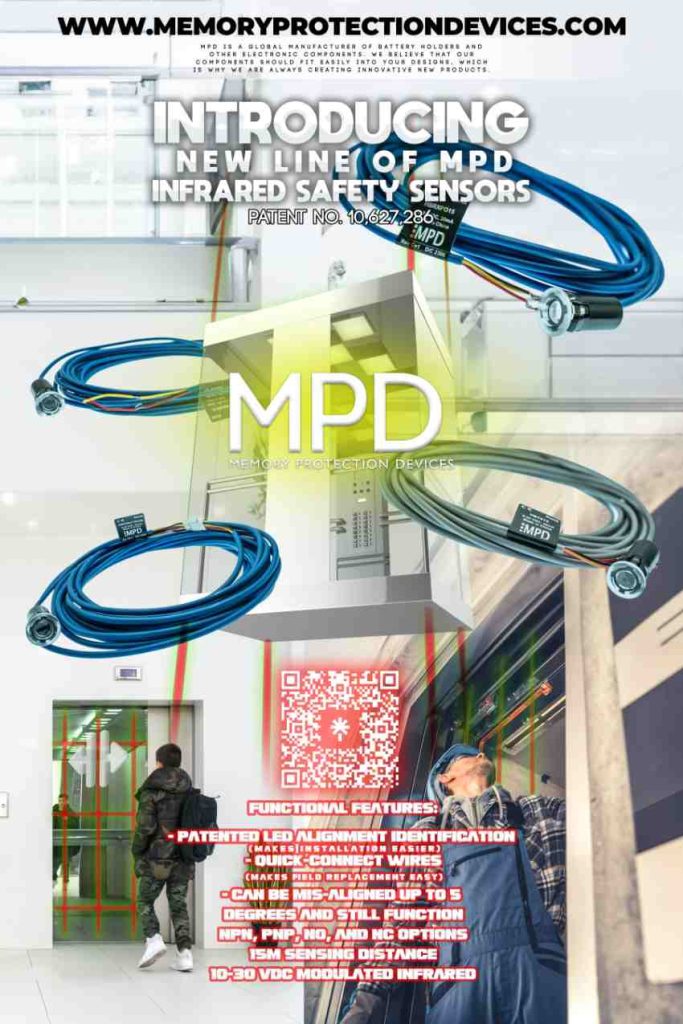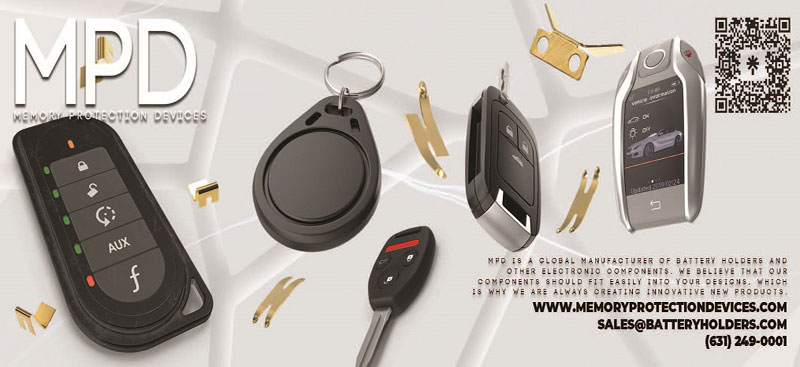Memory Protection Devices, Inc. (MPD) is an ISO 9001 certified global manufacturer of battery holders, battery contacts, auto plugs, auto sockets, fuse holders, DC jacks DC plugs, and other electronic components and devices. Their parts are manufactured to rigorous standards in factories located around the world, which meet not only the quality requirements, but the social ones as well. The company believes that many components have not been given as much thought as they deserve, and every day MPD works to find the next innovative design. After all, a defective component can cause complete failure in most devices, and a poorly designed one can cause many inconveniences to end users. It is due to this core value that MPD is viewed as the industry’s leading innovator.
Easy Engineering: What are the main areas of activity of the company?
MPD has 4 main lines of products. Battery holders, Fuse holders, 12 Volt parts, and our newest line Infrared Safety Sensor Beams.
E.E: What’s the news about new products/services?
MPD, on average, creates 3-5 new products every year. We send out a newsflash to our customers, a press release is also sent to everyone and a copy is set on our website.
E.E: What are the ranges of products/services?
Products and services include electronic design, prototypes and mass production for Battery holders, contacts and sockets and other power connection related products. Since 1980, Memory Protection Devices, Inc has been offering battery holders and contacts for lithium coin cells and alkaline cells. We offer products based on a range of standard products and custom proprietary solutions.

E.E: What is the state of the market where you are currently active?
The battery holder industry is currently being influenced by several key trends that are shaping its future direction and impacting purchasers.
- Advancements in battery Technology
- Materials Challenge and Alternatives
- Impact on the Market
E.E: What can you tell us about market trends?
1. Advancements in battery Technology: The industry is moving towards the adoption of solid-state batteries, which offer a significant improvement over traditional lithium-ion batteries in terms of energy density and safety. Solid-state batteries are expected to be lighter, smaller, and have a higher energy capacity, making them suitable for a wider range of applications. This includes electric vehicles (EVs), electronics, and renewable energy systems.
2. Materials Challenge and Alternatives: The traditional lithium-ion batteries, which have been the standard, are facing challenges due to the high demand and cost of materials like cobalt. This has led to the exploration of alternative materials, such as lithium iron phosphate (LFP) batteries, which use cheaper materials but at the cost of reduced energy density. There is also growing interest in nickel-metal hydride (NiMH) batteries, particularly for their application in hybrid and plug-in EVs due to their longer battery life and range.
3. Impact on the Market: These advancements and chips in technology are affecting the battery holder market. Battery holders, which are essential for housing and connecting batteries in devices, are seeing increased demand in sectors like automotive, military, and medical due to the rising use of advanced batteries. The shift towards electric vehicles has significantly increased the demand for battery holders, as companies like Tata Motors and M.G. Car Company have introduced new electric vehicles in markets like India.

4. Market Segmentation and Growth: The battery holder market is segmented by product types like AA battery holders, AAA battery holders, and coin battery holders, and by applications across various end-user sectors like consumer electronics, automotive, and industrial applications. This segmentation is crucial for understanding consumer interests and purchasing preferences, helping companies to make better business decisions and focus resources on market segments that align with their goals.
Given these trends, companies in the battery holder industry need to consider several factors in their strategic planning:
- R&D Investment: Companies should invest in research and development to align with the shift towards advanced battery technologies like solid-state batteries.
- Material Alternatives: Exploring alternative materials for battery manufacturing can help mitigate supply chain risks and reduce costs.
- Market Adaptation: Adapting products to suit the changing needs of sectors like automotive and consumer electronics, which are rapidly evolving with new battery technologies.
- Regional Market Analysis: Understanding regional market dynamics and tailoring strategies to different geographic areas, considering the varying demand and regulatory environments.
Overall, the battery holder industry is at a crucial juncture where technological advancements in batteries are creating new opportunities and challenges, requiring companies to adapt and innovate to stay competitive and meet the evolving needs of the market.

E.E: What are the most innovative products/services marketed?
We specialize in custom projects of all sorts. Our latest innovation is our IR safety sensor beams with patented technology. Our beams can be misaligned up to 5 degrees and will automatically realign themselves and continue working.
E.E: What estimations do you have for the beginning of 2024?
As we bid adieu to the whirlwind of innovations that characterized 2023, we find ourselves standing on the cusp of another thrilling year in the realm of electronic product design. The astonishing strides made over the past year have transformed our lives, propelling us into an era of unprecedented connectivity and convenience. Yet, as we peer into the future, the question beckons: what marvels lie ahead in 2024? The past year was a testament to the relentless pursuit of excellence within the electronic industry. Designers, engineers, and visionaries collaborated to orchestrate a symphony of ingenuity, introducing a dazzling array of new components, tools, and technologies. From the integration of AI-powered assistants into everyday
devices to the expansion of 5G networks that united us in a digital embrace, 2023 painted a vivid canvas of technological possibilities. As we stand at the precipice of a new year, the curtain rises on a stage set for technological marvels that defy our imagination. Just as 2023 surprised us with its cascade of innovation, 2024 holds the promise of even more extraordinary breakthroughs. From the symphony of 5G connectivity to the ballet of AI’s interaction with reality, the unfolding narrative of electronic product design beckons us to embrace the unknown with open arms.

